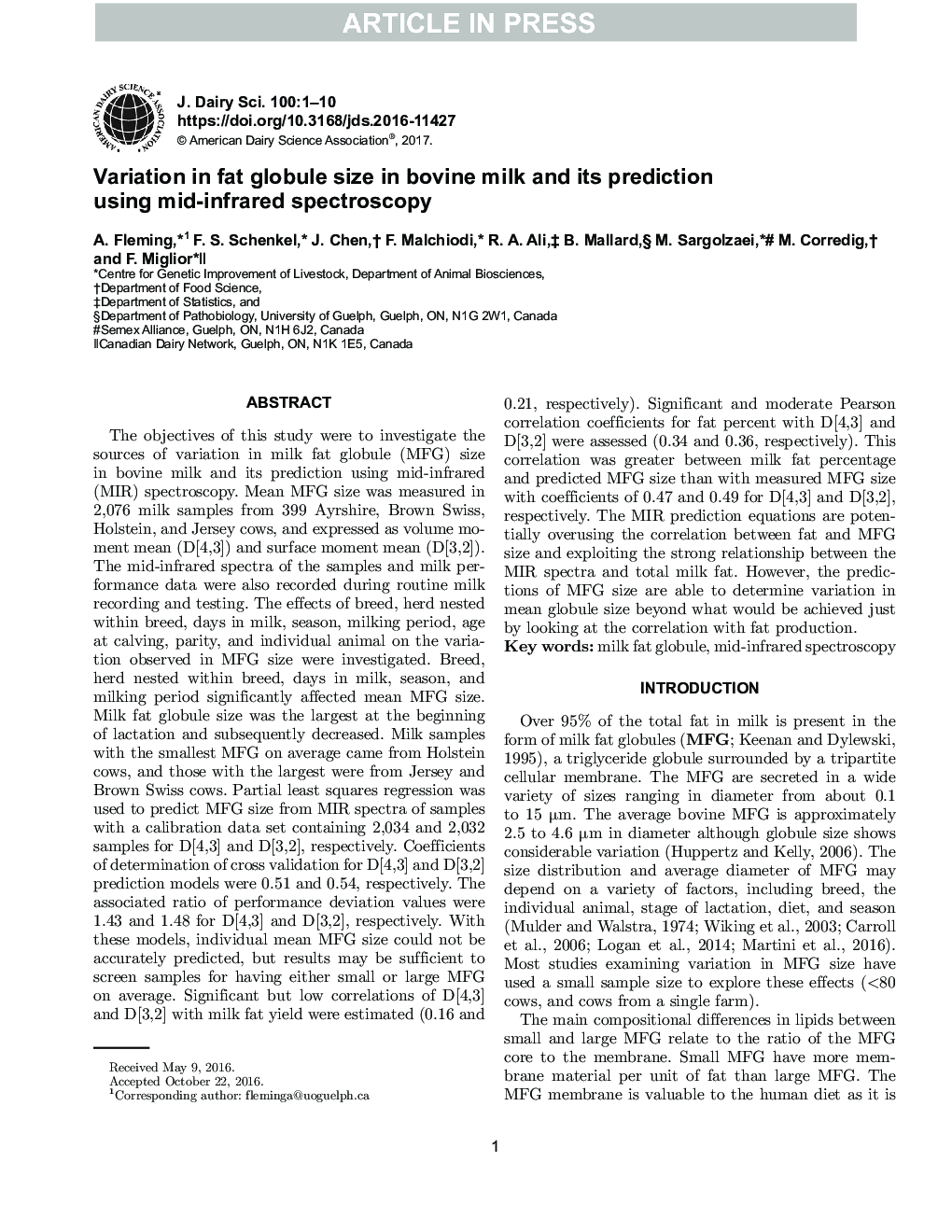| کد مقاله | کد نشریه | سال انتشار | مقاله انگلیسی | نسخه تمام متن |
|---|---|---|---|---|
| 5542473 | 1402519 | 2017 | 10 صفحه PDF | دانلود رایگان |
عنوان انگلیسی مقاله ISI
Variation in fat globule size in bovine milk and its prediction using mid-infrared spectroscopy
ترجمه فارسی عنوان
تغییر اندازه گلوبول چربی در شیر گاو و پیش بینی آن با استفاده از طیف سنجی مادون قرمز
دانلود مقاله + سفارش ترجمه
دانلود مقاله ISI انگلیسی
رایگان برای ایرانیان
کلمات کلیدی
گل چربی چربی، طیف سنجی نیمه مادون قرمز،
موضوعات مرتبط
علوم زیستی و بیوفناوری
علوم کشاورزی و بیولوژیک
علوم دامی و جانورشناسی
چکیده انگلیسی
The objectives of this study were to investigate the sources of variation in milk fat globule (MFG) size in bovine milk and its prediction using mid-infrared (MIR) spectroscopy. Mean MFG size was measured in 2,076 milk samples from 399 Ayrshire, Brown Swiss, Holstein, and Jersey cows, and expressed as volume moment mean (D[4,3]) and surface moment mean (D[3,2]). The mid-infrared spectra of the samples and milk performance data were also recorded during routine milk recording and testing. The effects of breed, herd nested within breed, days in milk, season, milking period, age at calving, parity, and individual animal on the variation observed in MFG size were investigated. Breed, herd nested within breed, days in milk, season, and milking period significantly affected mean MFG size. Milk fat globule size was the largest at the beginning of lactation and subsequently decreased. Milk samples with the smallest MFG on average came from Holstein cows, and those with the largest were from Jersey and Brown Swiss cows. Partial least squares regression was used to predict MFG size from MIR spectra of samples with a calibration data set containing 2,034 and 2,032 samples for D[4,3] and D[3,2], respectively. Coefficients of determination of cross validation for D[4,3] and D[3,2] prediction models were 0.51 and 0.54, respectively. The associated ratio of performance deviation values were 1.43 and 1.48 for D[4,3] and D[3,2], respectively. With these models, individual mean MFG size could not be accurately predicted, but results may be sufficient to screen samples for having either small or large MFG on average. Significant but low correlations of D[4,3] and D[3,2] with milk fat yield were estimated (0.16 and 0.21, respectively). Significant and moderate Pearson correlation coefficients for fat percent with D[4,3] and D[3,2] were assessed (0.34 and 0.36, respectively). This correlation was greater between milk fat percentage and predicted MFG size than with measured MFG size with coefficients of 0.47 and 0.49 for D[4,3] and D[3,2], respectively. The MIR prediction equations are potentially overusing the correlation between fat and MFG size and exploiting the strong relationship between the MIR spectra and total milk fat. However, the predictions of MFG size are able to determine variation in mean globule size beyond what would be achieved just by looking at the correlation with fat production.
ناشر
Database: Elsevier - ScienceDirect (ساینس دایرکت)
Journal: Journal of Dairy Science - Volume 100, Issue 3, March 2017, Pages 1640-1649
Journal: Journal of Dairy Science - Volume 100, Issue 3, March 2017, Pages 1640-1649
نویسندگان
A. Fleming, F.S. Schenkel, J. Chen, F. Malchiodi, R.A. Ali, B. Mallard, M. Sargolzaei, M. Corredig, F. Miglior,
